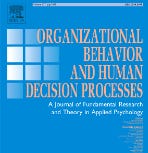Advancing Transparency and Open Science at OBHDP
To help foster rigorous, transparent, and reproducible research at OBHDP, we have formally adopted Level 2 of the Transparency and Openness Promotion (TOP) guidelines (effective January 1, 2025). Given that many of OBHDP’s prior policies already aligned with Level 2 standards, this “change” is intended to provide clear guidance rather than to substantially alter the submission process.
Submission guidelines
During the submission process, authors will be required to confirm that they understand and will adhere to Level 2 TOP standards. Our implementation of these standards can be found in the Guide for Authors and in a recent editorial (Baer & Kouchaki, 2025): https://www.sciencedirect.com/science/article/pii/S0749597825000019
Here is a quick summary of OBHDP’s transparency and openness guidelines:
• Data transparency: Authors are required to make all data available in a trusted online repository. (If there are restrictions on data sharing, this can be explained during submission.)
• Research materials transparency: Authors are required to make all study materials (e.g., surveys, experiment protocols and manipulations) available within the manuscript itself or on a trusted online repository.
• Analytic methods (code) transparency: Authors are required to make all analysis code/syntax/scripts available in a trusted online repository.
• Design and analysis reporting standards: Authors are required to follow all relevant aspects of the APA Style Journal Article Reporting Standards when disclosing/describing their research design and data analysis.
• Study and analysis plan preregistration: Authors are required to state which aspects of their studies were preregistered (e.g., hypotheses, exclusion criteria, analysis plan), and provide a link to the preregistration(s). We note that initial submissions that were not preregistered are eligible for peer review; at this stage it is only necessary to disclose whether studies were preregistered. If new data is requested during a revision, however, the new data collection(s) and analyses must be preregistered.
To indicate their compliance, authors will be asked to include a Research Transparency Statement in their manuscript. This concise statement will also include links to all materials hosted on external sites (e.g., surveys, manipulations, preregistrations, data, and analysis code/syntax). Please see the Guide for Authors for sample Research Transparency Statements.
As authors tackle these new guidelines, we urge reviewers to approach manuscripts with an assumption of positive intent, recognizing that gaps in transparency are often due to unfamiliarity rather than deliberate omission. Our goal is for authors, reviewers, and editors to work collaboratively to foster greater openness, reproducibility, and collaboration.
We look forward to working with you as we embrace these improvements in scientific transparency!
P.S. if you can’t access the full-text let us (m-kouchaki@kellogg.northwestern.edu or mikebaer@asu.edu) know and we’d be happy to share a copy.


